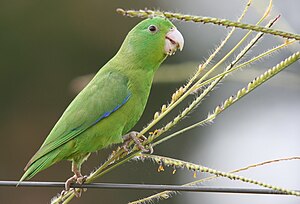Blue-winged parrotlet
| Blue-winged parrotlet | |
|---|---|
 |
|
| Male in Goias, Brazil | |
| Scientific classification | |
| Kingdom: | Animalia |
| Phylum: | Chordata |
| Class: | Aves |
| Order: | Psittaciformes |
| Superfamily: | Psittacoidea |
| Family: | Psittacidae |
| Subfamily: | Arinae |
| Genus: | Forpus |
| Species: | F. xanthopterygius |
| Binomial name | |
|
Forpus xanthopterygius (Spix, 1824) |
|
| Synonyms | |
|
Forpus crassirostris (Taczanowski, 1883) |
|
Forpus crassirostris (Taczanowski, 1883)
The blue-winged parrotlet (Forpus xanthopterygius) is a small parrot found in much of South America. It includes the turquoise-rumped parrotlet (Forpus xanthopterygius spengeli), which sometimes is treated as a separate species. The blue-winged parrotlet is mainly found in lowlands, but locally up to 1200m in south-eastern Brazil. It occurs in woodland, scrub, savanna, and pastures. Flocks are usually around 20 birds but can grow to over 50 around fruiting trees or seeding grasses. It is generally common and widespread, though more localized in the Amazon Basin.
The blue-winged parrotlet is a short (12 cm) stocky mainly green bird with a short tapered tail. Sexually dimorphic, the males have blue on the primary and underwing coverts, the remiges and the rump (blue in wings greatly reduced in F. x. spengeli). The face, ear coverts, thighs and vent area are a brighter emerald green. Females, which lack the identifying blue coloration, are easily confused with the green-rumped parrotlet, but there is little overlap in their distributions. The subspecies varies primarily in the overall darkness and the amount of yellow to the plumage.
For a while it was considered conspecific with the green-rumped parrotlet (F. passerinus), but today all authorities recognized the two as separate species. It is also possible that the subspecies spengeli is better classified as a subspecies of the Mexican parrotlet (F. cyanopygis), or, more likely, a species of its own, the turquoise-rumped parrotlet (F. spengeli).
...
Wikipedia

